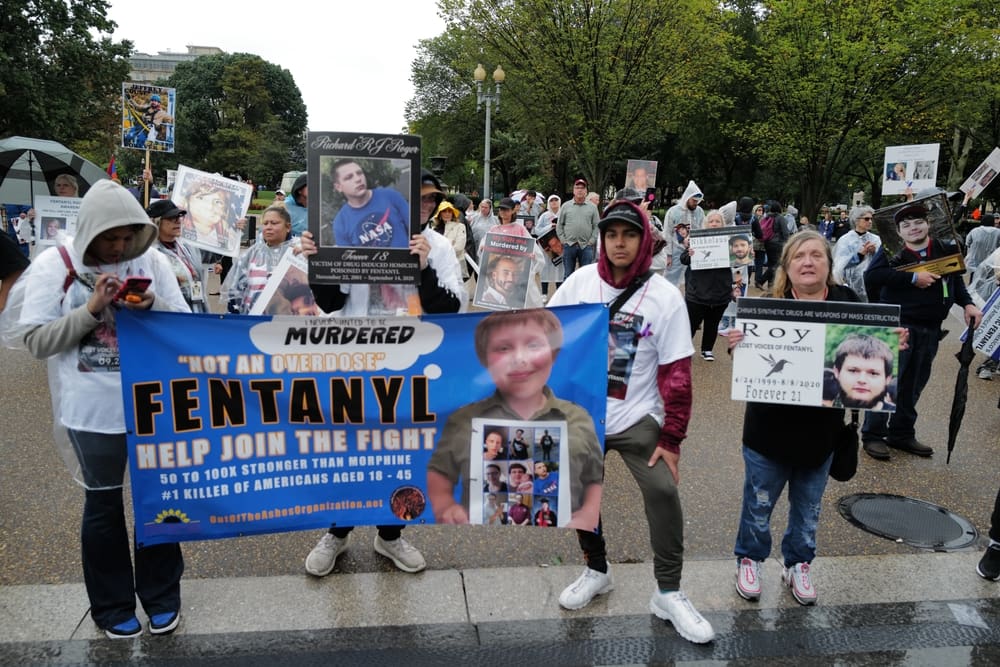The fentanyl crisis among teens has reached a critical point, demanding immediate attention. Fentanyl, a synthetic opioid 50 to 100 times more potent than morphine, has permeated the illicit drug market, leading to a drastic surge in overdose deaths among adolescents who often seek illicit drugs on the internet (e.g. Xanax Valium, Quaaludes, etc.). These illicit drugs bought on the internet are often “mixed” with fentanyl due to the low cost of producing fentanyl. Disguised as common prescriptions like Xanax, Percocet, or Adderall, fentanyl is now easily accessible through social media and peer networks, luring unsuspecting teens into fatal poisonings. Even a tiny dose—just two milligrams, smaller than a grain of salt—can be deadly.
The numbers are shocking: In 2022, an average of 22 American teens died from overdoses each week, with Fentanyl involved in nearly 84% of these cases.1 In 2021, fentanyl-related deaths among adolescents nearly tripled compared to previous years. This rise in fatalities is not due to increased drug use, as adolescent drug use has declined over the past two decades, from nearly 21% to about 8% among 12th graders.2 The actual threat lies in the lethality of counterfeit pills laced with fentanyl.
Some regions of the Country are facing particularly high fatality rates among teens. In areas like Arizona, Colorado, and Washington, overdose rates are double the national average. In Maricopa County, Arizona, alone, 117 teens lost their lives due to fentanyl overdoses in one year; Los Angeles County reported 111 deaths in the same timeframe. Other heavily impacted counties include King County, Washington; Cook County, Illinois; and Orange County, California. American Indian and Alaska Native teens have been hit especially hard, with overdose rates nearly double those of their white counterparts.3
What makes fentanyl especially dangerous for teens is its potency and ability to mimic other sedative drugs. Teens often purchase counterfeit pills online, believing they are safe, prescription-grade medications. Joseph Friedman, a researcher at UCLA, states that these fake pills are so convincingly similar to legitimate prescription medications that teens cannot tell the difference visually.4 Tragically, for many, an attempt to self-medicate or recreationally experiment with one of these counterfeit pills often ends fatally.
Social media has amplified the problem. Platforms like Snapchat, Instagram, and TikTok have become venues for dealers to market and distribute fentanyl-laced pills. Sellers use these platforms to evade detection, connecting with teens directly in private channels or on the dark web. While social media companies have attempted to limit drug-related content by using AI to flag and remove dangerous listings, the problem persists. However, their efforts are often reactive (not proactive) and not comprehensive, leaving our society with a daunting task to monitor and deter teens and arrest drug dealers. The anonymity of online transactions, combined with the perceived safety of familiar social media platforms, makes them attractive avenues for teenagers and young adults seeking illicit substances.5
In response, schools across the country are stepping up to protect students. Districts in high-risk areas are stocking naloxone (Narcan), a medication that reverses opioid overdoses. Los Angeles Unified School District, the largest in the nation, began distributing naloxone across all its schools in 2022. School leaders have also revamped their anti-drug programs, moving beyond “just say no” rhetoric to teach students specific, real-life dangers of fentanyl poisoning. Some schools are even advocating for fentanyl test strips to help students identify laced pills, though these strips remain illegal in several states, where they are classified as drug paraphernalia.3 Companies, such as “Belay” (webelay.com) have created “emergency medication boxes” (similar to AED defibrillators, to make drugs like Narcan/naloxone available to public places.
This public health crisis requires multifaceted responses from schools, healthcare providers, and families. The CDC and other health organizations recommend open conversations between parents and teens about the dangers of counterfeit pills, emphasizing that any pill not prescribed by a doctor carries a high risk of being counterfeit and may contain improperly labelled dosages or fentanyl. Experts advise that families learn to recognize the signs of fentanyl overdose and consider keeping naloxone on hand, as its immediate administration can prevent fatalities.1,6
The fentanyl crisis underscores the need for comprehensive, systemic interventions. Dr. Scott Hadland, chief of adolescent medicine at Mass General for Children, advocates for partnerships across sectors—including public health, law enforcement, social media companies, and policy advocacy—to curb the availability of counterfeit drugs, regulate social media transactions, and ensure the availability of harm-reduction tools like naloxone and test strips.6 These measures, Hadland emphasizes, are crucial in addressing the extreme public health threat that spans online spaces, schools, and communities.
While schools, communities and government agencies are mobilizing, the fight against teen fentanyl poisoning remains challenging. Parents and advocates are calling for stronger regulation, more robust anti-drug education programs, and more accessible naloxone via public access stations or free dispensing of naloxone. Many argue for starting drug education earlier, with outreach programs beginning in middle school to arm students with knowledge before they encounter peer pressure or curiosity about drugs or getting high at concerts occurs. Early education can help build a strong foundation of awareness and resistance against drug use, potentially preventing future cases of fentanyl poisoning.
The crisis of teen fentanyl poisoning underscores the need for comprehensive awareness, education, and intervention strategies and access to life saving emergency drugs like naloxone. As counterfeit drugs continue to flood the market, the risks associated with recreational drug use for teens have grown exponentially. For today’s youth, what might once have seemed like low-risk experimentation can now be a matter of life and death. Addressing this crisis demands a coordinated and sustained response from parents, educators, healthcare providers, and policymakers alike. Each stakeholder (individuals, schools, communities, government agencies, etc.) has a unique role to play, and only through collective action can we effectively protect the next generation. Recently, the author has been contacted by Andrew Schneider, the Chief Executive of FON (Family Office Network) to further understand and help understand and aide in the struggle against opioid overdoes and fentanyl poisonings. As a big supporter of the incoming Federal administration, FON has begun outreach to support local and Federal agencies via his large network of family offices.
Samuel Herschkowitz, M.D.
917-548-8181
References
- Centers for Disease Control and Prevention (CDC). “Drug Overdose Deaths.” CDC.gov, 2023. [https://www.cdc.gov/drugoverdose/deaths/index.html](https://www.cdc.gov/drugoverdose/deaths/index.html).
- National Institute on Drug Abuse (NIDA). “Overdose Death Rates and Trends Among Youth.” NIDA.nih.gov, 2024. [https://nida.nih.gov/research-topics/trends-statistics/overdose-death-rates](https://nida.nih.gov/research-topics/trends-statistics/overdose-death-rates).
- Thompson, Dennis. “America’s Teens Are Being Poisoned by Fentanyl.” HealthDay News, 2024.
- Friedman, Joseph. “Teenagers and the Rise of Counterfeit Pills: How Fentanyl Is Increasing Teen Deaths.” University of California, Los Angeles News Release, 2024.
- The New York Times. “The Deadly Reach of Fentanyl on Social Media.” The New York Times, 15 Sept. 2022. [https://www.nytimes.com/interactive/2022/09/15/us/fentanyl-teens-social-media.html](https://www.nytimes.com/interactive/2022/09/15/us/fentanyl-teens-social-media.html).
- Hadland, Scott. “Teen Fentanyl Poisoning and the Role of Naloxone in Schools.” Mass General for Children, 2024.




